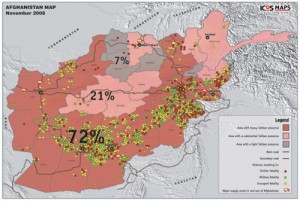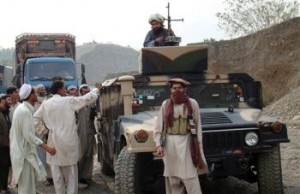Counterinsurgency on the Southern U.S. Border
BY Herschel SmithFriend of The Captain’s Journal David Danelo has a must read concerning the situation at the Southern U.S. border. Here is the full commentary followed by our own analysis.
On Nov. 3, the day before Americans elected Barack Obama president, drug cartel henchmen murdered 58 people in Mexico. It was the highest number killed in one day since President Felipe Calderon took office in December 2006. By comparison, on average 26 people — Americans and Iraqis combined — died daily in Iraq in 2008. Mexico’s casualty list on Nov. 3 included a man beheaded in Ciudad Juarez whose bloody corpse was suspended along an overpass for hours. No one had the courage to remove the body until dark.
The death toll from terrorist attacks in Mumbai two weeks ago, although horrible, approaches the average weekly body count in Mexico’s war. Three weeks ago in Juarez, which is just across the Rio Grande from El Paso, Texas, telephone messages and banners threatened teachers that if they failed to pay protection money to cartels, their students would suffer brutal consequences. Local authorities responded by assigning 350 teenage police cadets to the city’s 900 schools. If organized criminals wish to extract tribute from teachers, businessmen, tourists or anyone else, there is nothing the Mexican government can do to stop them. For its part, the United States has become numb to this norm.
As part of my ongoing research into border issues, I have visited Juarez six times over the last two years. Each time I return, I see a populace under greater siege. Residents possess a mentality that increasingly resembles the one I witnessed as a Marine officer in Baghdad, Fallouja and Ramadi.
“The police are nothing,” a forlorn cab driver told me in September. “They cannot protect anyone. We can go nowhere else. We live in fear.”
An official in El Paso estimated that up to 100,000 dual U.S.-Mexican citizens, mostly upper middle class, have fled north from Juarez to his city this year. Only those lacking means to escape remain.
At the same time, with the U.S. economy in free fall, many illegal immigrants are returning south. So illegal immigration — the only border issue that seems to stir the masses — made no splash in this year’s elections. Mexico’s chaos never surfaced as a topic in either the foreign or domestic policy presidential debates.
Despite the gravity of the crisis, our closest neighbor has fallen off our political radar. Heaven help you if you bring up the border violence at a Washington dinner party. Nobody — Republican or Democrat — wants to approach this thorny discussion.
Mexico, our second-largest trading partner, is a fragmenting state that may spiral toward failure as the recession and drug violence worsen. Remittances to Mexico from immigrant labor have fallen almost 20% in 2008. Following oil, tourism and remittances, drugs are the leading income stream in the Mexican economy.
While the bottom is dropping out of the oil and tourism markets, the American street price of every narcotic has skyrocketed, in part because of recent drug interdiction successes along the U.S. border.
Unfortunately, this toxic economic cocktail also stuffs the cartels’ coffers. Substitute tribal clans for drug cartels, and Mexico starts to look disturbingly similar to Afghanistan, whose economy is fueled by the heroin-based poppy trade.
Arizona Gov. Janet Napolitano, Obama’s pick for Homeland Security director, has argued for permanently stationing National Guard troops along the border. That response alone will do little to assuage American border citizens. To them, talk of “violence bleeding over” is political pabulum while they watch their southern neighbors bleed.
If Napolitano wishes to stabilize the border, she will have to persuade the Pentagon and the State Department to take a greater interest in Mexico. Despite Calderon’s commendable efforts to fight both the cartels and police corruption, this struggle shows no signs of slowing. When 45,000 federal troops are outgunned and outspent by opponents of uncertain but robust size, the state’s legitimacy quickly deteriorates.
The Mexican state has not faced this grave a challenge to its authority since the Mexican revolution nearly a century ago.
If you want to see what Mexico will look like if this pattern continues, visit a border city like Tijuana, where nine beheaded bodies were discovered in plastic bags 10 days ago. Inhale the stench of decay. Inspect the fear on the faces. And then ask yourself how the United States is prepared to respond as Mexico’s crisis increasingly becomes our own.
David J. Danelo is the author of “The Border: Exploring the U.S.-Mexican Divide” and “Blood Stripes: The Grunt’s View of the War in Iraq.”
To set background in place for the analysis below, see the following video. Mexican labor has become the new slave class for Corporate America.
The situation at the border with Mexico has become as classical an insurgency as anywhere in the world, and because of the complicity of American business fishing for cheap labor, lack of traceability of employment records, no health insurance payments, no retirement payments, and no social security payments, we are now relegated to the solution to militarize the Southern border.
Further, even militarization of the border won’t fully solve the issue unless massive changes are made to both the rules under which the military would operate and our understanding of the seriousness of the situation. In Guardsmen Attacked and Overrun at U.S. Border we discussed the horribly failed attempt to use the National Guard to secure the border. The National Guard had no ammunition in their weapons, could only put themselves at mortal risk in order to apprehend suspects, and weren’t even allowed to fire warning shots.
Unlike the citizens of New Orleans after Katrina who usually stopped for armed police (not realizing that the police are not allowed to use deadly force to stop a fleeing suspect), the border is infested with rogue elements who know better. Militarization of the border would mean full scale implementation of the rules associated with the SCOTUS decision Tennessee v. Garner 471 U.S. 1 (1985) on criminals who wouldn’t respect the military and would use the rules against them.
The intrusiveness of a seizure by means of deadly force is unmatched. The suspect’s fundamental interest in his own life need not be elaborated upon. The use of deadly force also frustrates the interest of the individual, and of society, in judicial determination of guilt and punishment. Against these interests are ranged governmental interests in effective law enforcement. It is argued that overall violence will be reduced by encouraging the peaceful submission of suspects who know that they may be shot if they flee.
Without in any way disparaging the importance of these goals, we are not convinced that the use of deadly force is a sufficiently productive means of accomplishing them to justify the killing of nonviolent suspects. Cf. Delaware v. Prouse, supra, at 659. The use of deadly force is a self-defeating way of apprehending a suspect and so setting the criminal justice mechanism in motion. If successful, it guarantees that that mechanism will not be set in motion. And while the meaningful threat of deadly force might be thought to lead to the arrest of more live suspects by discouraging escape attempts, the presently available evidence does not support this thesis.
Whether MS 13, other criminals and drug runners, or foreign terrorists who enter the U.S. via the Southern border, the U.S. is in real trouble concerning national sovereignty. David has done important work in informing us of the scope of the risk at the border.
Prior:





